First Foods – Pureed Baby Food Recipes
With these simple pureed baby food recipes, discover which delicious fruits and vegetables you can introduce to your little one.
Vegetables
Scrumptious Sweet Potato
This has to be one of our all-time favourite first baby foods. All our children have loved it,probably because of its subtle sweetness. And it is, by far, the easiest vegetable to prepare.
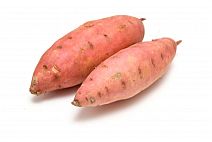
- Preheat the oven to 375 deg F or 190 deg C.
- Simply take one large sweet potato. Scrub it and prick it with a fork.
- Bake for about 45 mins or so (depending on the size), until it feels soft.
- Once cooked, all you need to do is split the potato and scrape out the flesh with a spoon. Hey presto – instant baby food, which doesn’t even need pureeing!
- Just mash it lightly with a fork and you’re ready to go.
One large potato will give you about 3 or 4 portions at this early stage.Bake a few at a time and you’ve got a fortnight’s supply!
Alternatively… you could peel the potato, then boil or steam it in cubes. But really, what’s the point in giving yourself extra work when baking it in its skin is so much easier?
One point to consider – one of our daughters loved sweet potato so much that we fed it to her a little too often – her skin took on an orange hue! It actually looked as if she had a healthy tan – so much so, that we considered trying the sweet potato diet for ourselves! So be careful not to over do it.
Delicious Butternut Squash
Another simple-to-prepare vegetable, with a taste that babies love. You could also use acorn squash.
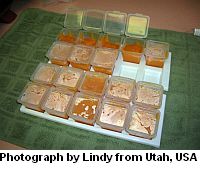
- Preheat the oven to 400 deg F or 200 deg C.
- Cut the squash in half and remove the seeds.
- Place the squash in a baking tin, face down in about one inch of water.
- Bake for about 40 mins. Keep an eye on the water in the pan – add a little more if necessary.
- The squash is done when it feels soft.
- Remove the flesh from the skin and either puree it, or mash it lightly with a fork.
Get lots more butternut squash baby food recipes, tips and ideas
Tender Carrots
One of the most popular first solid foods for baby - and possibly the cheapest! It makes you wonder why people are prepared to pay so much for jars of foods, when you see how economical these are to prepare at home!

- Choose large, older carrots - these are actually richer in nutrients than baby carrots.
- Just trim the ends and slice.
- Then steam, boil or microwave and puree to perfection!
Tasty Zucchini (Courgettes)
Zucchini purees to a very thin, almost watery consistency. Introduce them on their own at first (as per the four day rule), then mix them with other vegetables that may otherwise be a little too “stodgy” in texture.
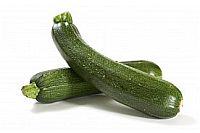
- Simply wash the zucchini, remove both ends, then slice.
- You can boil in a very little water, steam or microwave them until tender, then puree them as usual.
Superb Swede (Rutabaga)
Swede (or rutabaga) is often neglected as a food for babies, yet it has a lovely, earthy flavour that our children have all enjoyed.
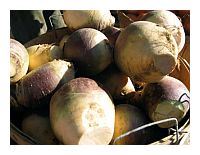
- Simply peel the swede, cut it into chunks and then boil, steam or microwave until tender (swede takes around the same time as white potatoes to cook). It is very easy to puree to a wonderful, smooth consistency.
Luxurious Asparagus
Green asparagus is better for your baby than white because it is higher in calcium, protein and B vitamins.

- A real treat for baby – and easy to prepare – just remove the woody stems by bending each spear until it snaps – it should snap at the point where the fresh green tip ends and the tougher part begins.
- After washing the tips, tie them in a bundle to steam them – (there are special asparagus steamers designed for the purpose!). Alternatively, boil them in a little water for 5-7 minutes.
- Finally, puree or mash the asparagus tips as desired.
TIP: Don’t cook asparagus in iron pots. The tannins in asparagus react with the iron and discolour the stems.
Wholesome Baked Potato
Standard potatoes can be peeled then boiled, but we prefer to bake them in their skins.

- Use the same method as for sweet potatoes, but increase the cooking time to around 1 1/2 hours. You should just need to mash the potato with a fork and maybe add a little formula or breastmilk to give a smooth consistency.
We wouldn’t recommend pureeing this type of potato – it ends up like glue!
Plain potato can be a bit bland for baby – we always prefer to “partner it up” with another vegetable, rather than serve it on its own.
Other Vegetables To Try
- Green beans – top and tail, remove any strings, then steam, boil or microwave.
- Parsnips – follow the preparation method for carrots. Babies love the sweetness of parsnips.
- Green peas – use fresh shelled peas or frozen peas.
- Eggplant/aubergines – peel, then steam or bake.
- Broccoli – wash, then boil, steam or microwave the florets. Beware of the stems – they give some babies gas!
Tasty Vegetable Combos
Easy vegetable and rice delight
cooked brown rice
broccoli
carrots
green beans
squash
- Use the quantities of each vegetable that best suit your baby’s preferences – this can be a good way of getting him to eat a vegetable that he has previously refused!
- Prepare the vegetables, then steam them. Start the carrots off first, then the squash, as they take the longest to cook.
- Once cooked, mix the vegetables with the rice, then puree to the desired consistency, adding a little breast milk or formula if necessary.
Once you have safely introduced these different types of vegetables, then it’s time to “mix ‘n match”. You can mix any number of vegetables in any combination you choose, but these are some tried and tested favourites of ours that you might like to try…
- Parsnips and green beans
- Mashed potato and carrots
- Sweet potato and squash
- Sweet potato and carrots
- Zucchini (courgettes) and mashed potato
- Swede (rutabaga) and carrots
- Green beans and peas
- Carrots and parsnips
More useful veggie links…
Sweet potato and chickpea puree
Lentil baby food tips and recipes
Preparing bell peppers for baby
Using beets (beetroot) in your recipes
Fruits
Healthy and delicious, fruits make wonderful first foods for babies. Not all fruits are suitable at this stage, though – see pureed baby food recipes – foods to avoid, for more information.
Brilliant Bananas
Most babies just LOVE bananas, perhaps the most nutritious of all the fruits. The taste, texture and ease of preparation makes them ideal for baby’s first food.
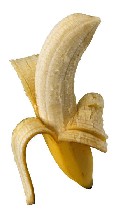
- The method of preparation is so simple, there is no method – just mash a ripe banana and baby’s meal is ready!
For very young babies, you can add a little formula or breastmilk for a runnier consistency.
Juicy Plums and Peaches
Plums, peaches and nectarines can all be prepared in the same way…
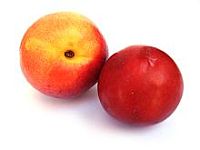
- Wash the fruit well, then cut an “x” into the side of the skin.
- Place the fruit, “x” side down, into about an inch of water and simmer until soft.
- It is then easy to remove the skin and stone, ready for pureeing.
Amazing Apples
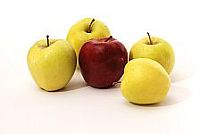
- Take a sweet dessert apple, then peel it, core it and cut it into quarters.
- Steam the chunks, or slice very thinly and simmer gently with about 1 tbsp of water, until soft.
- You can puree apple very easily by passing it through a sieve or fine strainer.
Learn how to make applesauce and find lots more apple baby food recipes
Perfect Pears
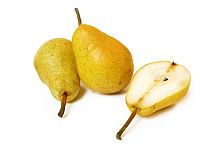
Pears can be peeled, cored and prepared like apples (above), although very ripe pears can be pureed without cooking for babies from 6 months of age.
Like apples, pears can sometimes be very runny in texture once pureed.
So, after you have safely introduced them to your baby, try using them in combination with another fruit … or vegetable!
Magnificent Melon
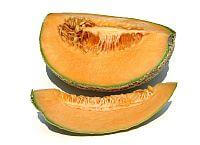
Cool cantaloupes, wonderful watermelons… they’re perfectly sweet and juicy and your baby will love them!
You don’t need to cook melon – just puree it and serve for a refreshing treat!
Nutritious Avocado Pear
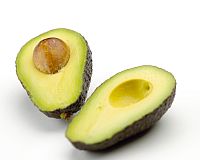
Avocado pear is highly nutritious, creamy in texture and a perfect baby food.
- Choose a ripe avocado, then simply peel and remove the stone.
- You can then mash the fruit with a fork – the consistency is similar to banana, so you won’t need to puree it any further
Fruit Combos
As with baby’s first vegetables, you can combine different fruits to create new flavours that your baby will adore. Our children all enjoyed these combinations –
- Peaches and pears
- Apples and pears
- Avocado and banana
If you’re in a hurry or fresh fruit is unavailable, you could use canned fruit instead of fresh. But make sure that the fruit is in its own juice, and not a sugary syrup!
Another idea is to stir a little fruit puree into some pure, non-flavoured natural yogurt (here’s a recipe to make your own).
It’s best to use a sweet fruit for this, as the yogurt itself is quite “tangy”.
But don’t be tempted to sweeten the yogurt with honey. Honey can be extremely dangerous for babies under one year of age. See foods to avoid for more information.
Remember to apply the four day rule as you introduce each new food to your baby, in order to identify any potential allergies or digestive problems.
To puree food for your baby, you can push it through a sieve or use a blender. (Click here to see all our recommended baby food processors, mills and grinders.)
Alternatively, consider using a hand blender – you can simply puree the food in the pot you cook it in, plus hand blenders are easy to clean up afterwards!
More accessories for making your own baby food
If your puree doesn’t come out with the consistency you’d intended, then don’t miss our tips for thickening or thinning baby food purees. PLUS – learn how adding wheat germ to your baby’s purees provides a huge nutritional boost!
Where would you like to go now….
Which is the best first food for baby?
Baby’s first rice cereal recipe

